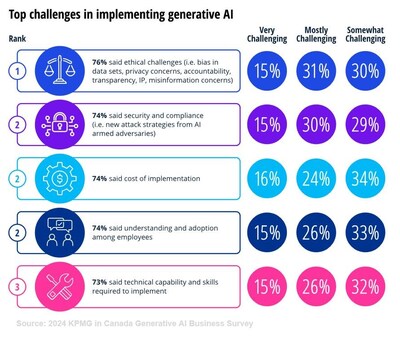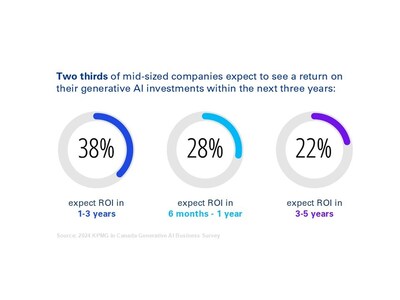
'Using both public and private generative AI tools is a smart approach,' says expert

Canadian businesses are increasingly turning to generative artificial intelligence (AI) as a driver of productivity and competitive advantage, according to a recent survey by KPMG in Canada.
The research, which involved 872 Canadian organizations, revealed that six out of 10 have integrated generative AI technology, with 89% of those companies identifying it as critical to their competitive strategy.
This swift adoption signifies a pivotal shift for Canadian businesses, says Stephanie Terrill, KPMG Canada’s managing partner of digital and transformation.
“It’s encouraging to see the rapid adoption of generative AI barely two years after it was introduced to the public,” she said. “Canadian organizations are embracing its transformative potential and realizing how it can help them gain a competitive advantage.”
Terrill emphasized that this transition could play a crucial role in addressing productivity challenges in Canada and that generative AI will likely define future business innovation.
In the realm of AI tools, many companies are strategically blending both public and proprietary platforms.
While 44% of respondents reported using a combination of public and private AI tools, 27% preferred private tools exclusively. This trend, KPMG suggested, arises from companies’ growing concerns over data privacy and security.
“Private generative solutions are ideal for keeping sensitive company data safe, but publicly available tools often have more advanced capabilities. Using both public and private generative AI tools is a smart approach, so long as organizations are strategic and deliberate about how they're using them,” said Terrill.
While 61% of Canadian companies have adopted generative AI, the path to full integration across operations remains challenging. The survey found only 36% of companies felt their generative AI systems were seamlessly integrated into their core workflows, with many still exploring how to leverage AI effectively.
Among the main hurdles are ethical concerns, security, implementation costs, and employee training. Terrill highlighted the need for cross-functional strategies in addressing these challenges. These would include diverse stakeholders, such as technology experts, board members, and third-party vendors. Collaboration and continuous training, she suggested, are key to overcoming these obstacles and fully realizing the technology’s potential.

The survey also underscored the importance of upskilling employees to support AI-driven changes. Although 88% of respondents said AI adoption has prompted them to rethink employee development, only 27% of companies currently require mandatory AI skills training.
This shortfall in training programs has prompted concern, especially as 71% of respondents expressed worry over employees using public AI tools without sufficient data privacy safeguards.
Walter Pela, KPMG in Canada’s AI client and market development leader, said this lack of training could expose companies to data risks. To counteract this, Pela advocated for clear training and guidelines to manage how employees interact with generative AI platforms.
Despite economic pressures, three out of four companies report prioritizing generative AI investments, with nearly half (45%) reporting focusing their investments on data analytics and IT functions.
In fact, 55% of companies plan to expand their generative AI spending within the IT department over the next five years, found KPMG.
Many also anticipate that these investments will soon yield returns: 38% of mid-sized companies expect to see results within one to three years, with productivity gains and profitability as the primary indicators of success.
Two thirds of respondents said they expect to see a return on their generative AI investments within the next three years – with 51 per cent measuring their ROI by improved productivity, and 47 per cent citing increased profitability as their preferred measure.

"Generative AI can boost productivity, but organizations need to figure out not only how they're going to measure productivity gains, but how they're going to reinvest those productivity gains. If they can do that, they will start to see their generative AI investments pay off in a bigger way," Terrill says.